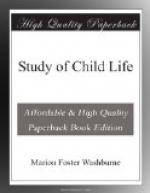This fault likewise often has a physical cause, seated very frequently in the liver. See that the child’s food is not too heavy. Give him much fruit, and insist upon vigorous exercise out of doors. Or he may perhaps not have enough childish pleasures. For while most children are overstimulated, there still remain some children whose lives are unduly colorless and eventless. A sullen child is below the normal level of responsiveness. He needs to be roused, wakened, lifted out of himself, and made to take an active interest in other persons and in the outside world.
[Sidenote: Inheritance and Example]
In many cases sullenness is an inherited disposition intensified by example. It is unchildlike and morbid to an unusual degree and very difficult to cure. The mother of a sullen child may well look to her own conduct and examine with a searching eye the peculiarities of her own family and of her husband’s. She may then find the cause of the evil, and by removing the child from the bad example and seeing to it that every day contains a number of childish pleasures, she may win him away from a fault that will otherwise cloud his whole life.
LYING
All lies are not bad, nor all liars immoral. A young child who cannot yet understand the obligations of truthfulness cannot be held morally accountable for his departure from truth. Lying is of three kinds.
(1.) The imaginative lie. (2.) The evasive lie. (3.) The politic lie.
[Sidenote: Imaginative “Lying”]
(1.) It is rather hard to call the imaginative lie a lie at all. It is so closely related to the creative instinct which makes the poet and novelist and which, common among the peasantry of a nation, is responsible for folk-lore and mythology, that it is rather an intellectual activity misdirected than a moral obliquity. Very imaginative children often do not know the difference between what they imagine and what they actually see. Their minds eye sees as vividly as their bodily eye; and therefore they even believe their own statements. Every attempt at contradiction only brings about a fresh assertion of the impossible, which to the child becomes more and more certain as he hears himself affirming its existence.
Punishment is of no use at all in the attempt to regulate this exuberance. The child’s large statements should be smiled at and passed over. In the meantime, he should be encouraged in every possible way to get a firm, grasp of the actual world about him. Manual training, if it can be obtained, is of the greatest advantage, and for a very young child, the performance every day of some little act, which demands accuracy and close attention, is necessary. For the rest, wait; this is one of the faults that disappear with age.
[Sidenote: The Lie of Evasion]




